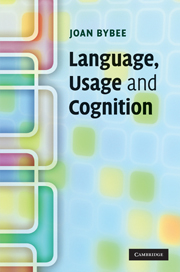Book contents
- Frontmatter
- Contents
- List of figures
- List of tables
- Acknowledgements
- 1 A usage-based perspective on language
- 2 Rich memory for language: exemplar representation
- 3 Chunking and degrees of autonomy
- 4 Analogy and similarity
- 5 Categorization and the distribution of constructions in corpora
- 6 Where do constructions come from? Synchrony and diachrony in a usage-based theory
- 7 Reanalysis or the gradual creation of new categories? The English Auxiliary
- 8 Gradient constituency and gradual reanalysis
- 9 Conventionalization and the local vs. the general: Modern English can
- 10 Exemplars and grammatical meaning: the specific and the general
- 11 Language as a complex adaptive system: the interaction of cognition, culture and use
- Notes
- Bibliography
- Index
8 - Gradient constituency and gradual reanalysis
Published online by Cambridge University Press: 05 June 2012
- Frontmatter
- Contents
- List of figures
- List of tables
- Acknowledgements
- 1 A usage-based perspective on language
- 2 Rich memory for language: exemplar representation
- 3 Chunking and degrees of autonomy
- 4 Analogy and similarity
- 5 Categorization and the distribution of constructions in corpora
- 6 Where do constructions come from? Synchrony and diachrony in a usage-based theory
- 7 Reanalysis or the gradual creation of new categories? The English Auxiliary
- 8 Gradient constituency and gradual reanalysis
- 9 Conventionalization and the local vs. the general: Modern English can
- 10 Exemplars and grammatical meaning: the specific and the general
- 11 Language as a complex adaptive system: the interaction of cognition, culture and use
- Notes
- Bibliography
- Index
Summary
Introduction
In previous chapters we have discussed the cognitive processes that interact to create the linguistic structure we think of as grammar. This chapter and the next argue further for these hypotheses by showing (i) how domain-general processes can create the cohesion among units that linguists regard as constituent structure and also account for gradual reanalysis (this chapter), and (ii) how conventionalization can create local patterns that might be considered ‘subgrammatical’ because they link properties that are not characteristic of grammar as traditionally defined (Chapter 9).
Chunking and constituency
In Chapter 3 we saw that the domain-general process of chunking could account for the conventionalization and cohesion (both phonetic and semantic) that is found in word groups that recur in experience. In Bybee 2002a I argued that constituent structure is derivable from the sequential chunking of material that tends to occur together. The main determinant of co-occurrence is of course meaning: units that are semantically relevant to one another tend to occur adjacent to one another in discourse (Haiman 1985). Thus demonstratives and determiners occur next to nouns, markers of aspect and tense occur near verbs, and so on. Semantically coherent sequences of units that have been chunked through repetition are then considered constituents.
The evidence that constituent structure itself is not a given but derivable from more basic processes is that these processes also apply in cases where traditional constituents do not emerge.
- Type
- Chapter
- Information
- Language, Usage and Cognition , pp. 136 - 150Publisher: Cambridge University PressPrint publication year: 2010



